#panel mount power switch
Explore tagged Tumblr posts
Text
Premium Reconditioned Circuit Breakers
Denver Breaker provides top-notch reconditioned circuit breakers, guaranteeing the highest quality for your electrical needs. Our expertly reconditioned breakers meet stringent safety standards, ensuring reliability. Trust Denver Breaker for efficient and dependable circuit breakers that won't break the bank. Upgrade your electrical systems with confidence. https://denverbreaker.com/
#reconditioned circuit breakers#electrical safety switch#circuit breaker#panel mount power switch#siemens electrical breakers
0 notes
Note
Cactus fascinates me, does it run on code similar to an existing instruction set or is it completely original on that front?
What can you do with it? What's it's storage?
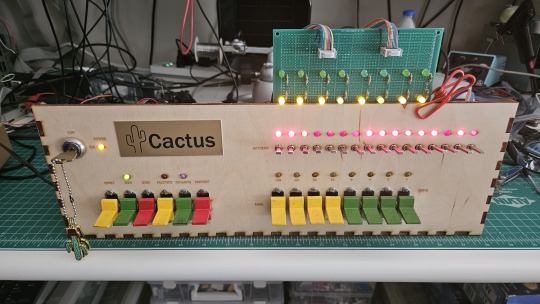
Both the Cactus (the original wooden prototype from years ago) and the new PCB Cactus(es) are essentially derived from a minimal 6502 computer design by Grant Searle for their core logic. Here's what that would look like on a breadboard:
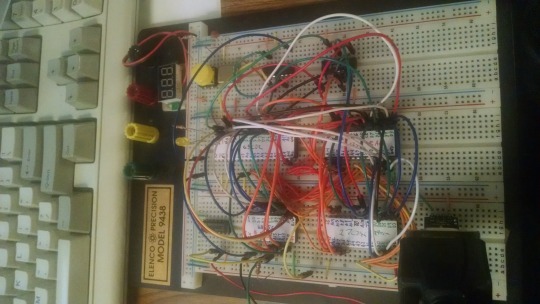
There isn't much to it, it's 32K of RAM, 16K of ROM containing Ohio Scientific's version of Microsoft BASIC, a 6850 ACIA for serial interaction, some logic gates, and of course a 6502 microprocessor (NMOS or CMOS, doesn't matter which). You hook it into a terminal and away you go.
Grant's design in turn can be best described as a distilled, modernized version of the OSI Challenger series of computers. Here's an OSI-400 and a Challenger 4P respectively:
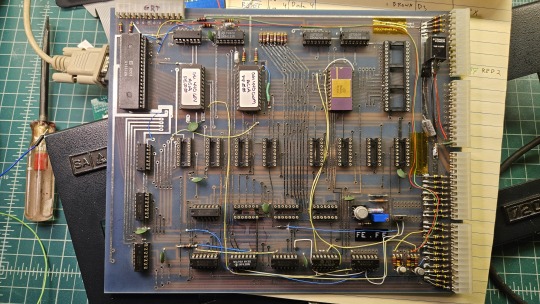

The left one is a replica of the 400 circa 1976, also called the Superboard. It was affordable, endlessly reconfigurable and hackable, but ultimately very limited in capabilities. No BASIC, minimal monitor ROM you talk to over serial, but you could connect it to a bus to augment its features and turn it into a more powerful computer.
Whereas the OSI C4P on the right from about 1979 has more RAM, a video card, keyboard, BASIC built in, serial interface, cassette tape storage, and that's just the standard configuration. There was more room to expand and augment it to your needs inside the chassis (alot changed in 3 years for home computer users).
Grant's minimal 6502 design running OSI BASIC is a good starter project for hobbyists. I learned about the 6502's memory map decoding from his design. I modified and implemented his design on a separate cards that could connect to a larger backplane.
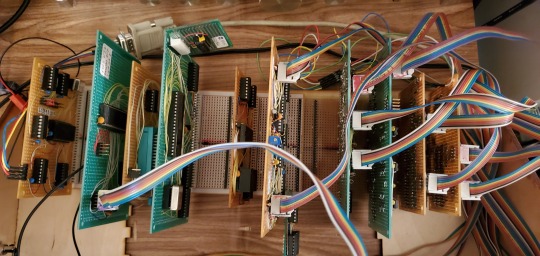
Here are the serial, ROM, RAM, and CPU cards respectively:
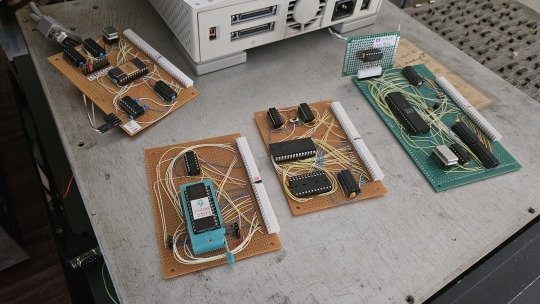
Each one is 100% custom, containing many modifications and fixes as I developed the design. However, that's only half of the computer.
I really wanted a 6502 machine with a front panel. People told me "nobody did that", or couldn't think of examples from the 1970s but that seemed really strange to me. Especially since I had evidence to the contrary in the form of the OSI-300:
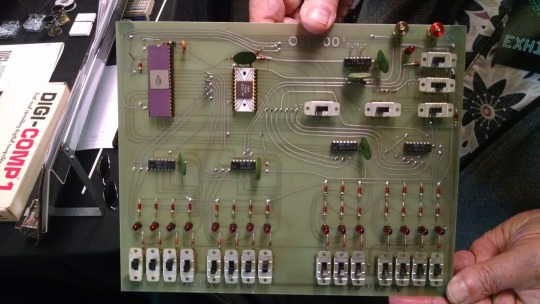
This one I saw at VCF West back in 2018 illustrates just how limited of a design it is. 128 bytes of RAM, no ROM, no serial -- just you, the CPU, and toggle switches and LEDs to learn the CPU. I was inspired the first time I saw one in 2015 at VCF East, which is probably when this whole project got set in motion.
Later that year I bought a kit for a miniature replica OSI-300 made by Christopher Bachman, and learned really quickly how limited the design philosophy for this particular front panel was. It was a major pain in the ass to use (to be clear, that's by OSI's choice, not any fault of Christopher in his implementation)

So... I designed my own. Took awhile, but that's the core of what the Cactus is: my attempt at experiencing the 1970s homebrew scene by building the computer I would have wanted at the time. Over half of the logic in the Cactus is just to run the front panel's state machine, so you can examine and modify the contents of memory without bothering the 6502. I added in all of the things I liked from more advanced front panels I had encountered, and designed it to my liking.
Here's the original front panel, accompanying logic, and backplane connected to the modern single board computer (SBC) version of the machine:
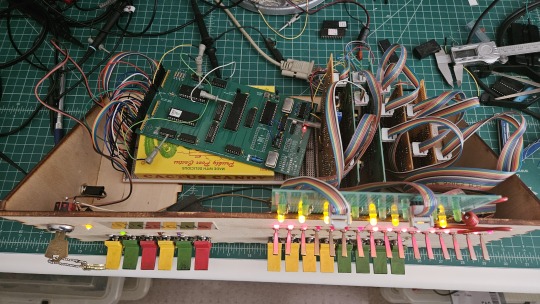
And here's the new Cactus SBC working with the new front panel PCB, which combines the logic, physical switch mountings, and cabling harnesses into a single printed circuit board.
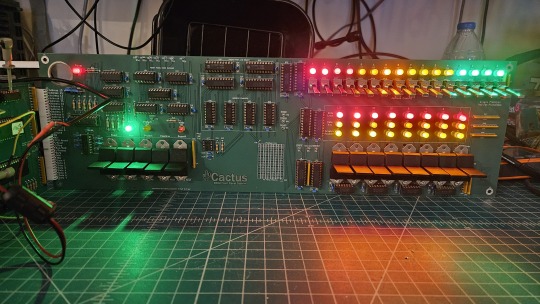
So, what can you do with it? Pretty much the same things I do already with other contemporary 1970s computers: play around in BASIC, fire up the occasional game, and tinker with it.
I've got no permanent storage designed for the Cactus as yet, it's been one of those "eventually" things. The good news is that a variety of software can be ported to the hardware without too much trouble for an experienced hobbyist. A friend of mine wrote a game called ZNEK in 6502 assembly which runs from a terminal:
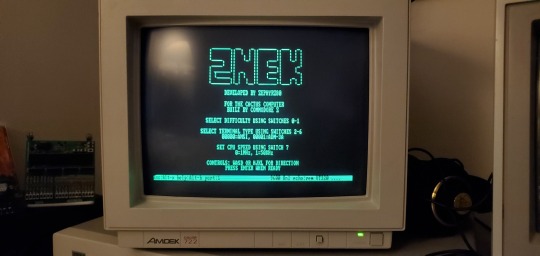
Right now, you have to either toggle in machine programs from the front panel from scratch, burn a custom ROM, or connect it to a serial terminal to gain access to its more advanced features:

Here's it booted into OSI BASIC, but I have also added in a modern descendant of Steve Wozniak's WOZMON software for when I need to do lower level debugging.
I've also got a video card now, based on the OSI-440. I have yet to implement a keyboard, or modify BASIC to use the video board instead of the serial connection. Even if I did, screen resolution is pretty limited at 24x24 characters on screen at once. Still, I'm working on that...
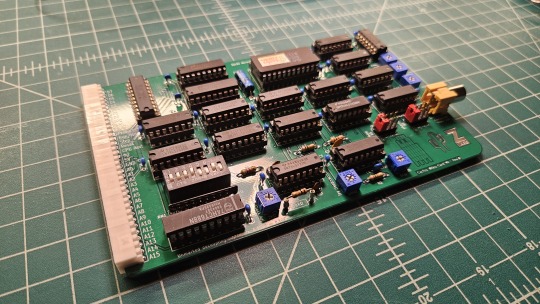

Anyway, I hope that answers your question. Check the tags below to see the whole process stretching back to 2017 if you're curious to learn more of the project's history. I'm also happy to answer any more questions you might have about the project.
267 notes
·
View notes
Text

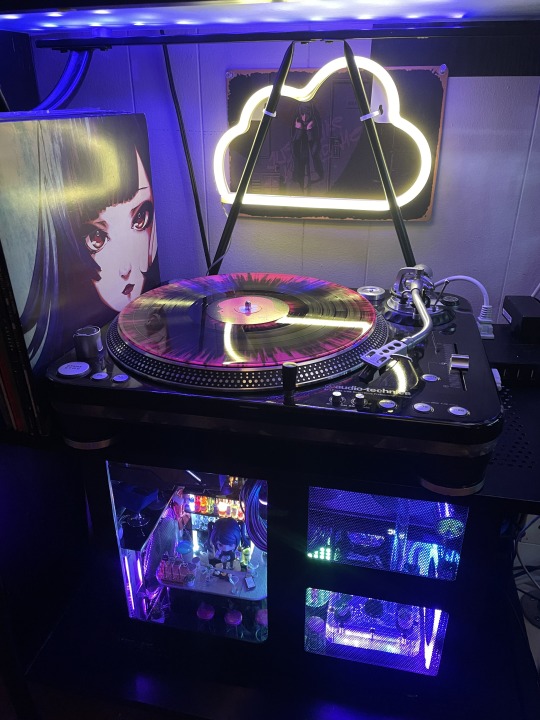


I built a miniature Va11 Hall-A Bar inside of my PC!!
Va11 Hall-A PC Parts & Build list
PC:
CPU : Intel I9 14900k
GPU: Intel Arc A770 16gb
Ram: Corsair Dominator 64gb 5600
Mobo: Maxsun Terminator Z790 D5 wifi
Hard drives M.2: Samsung 990 pro 2tb, Samsung 970 evo plus 1tb, CT 1tb, Adata 500gb
PSU: ROG Thor 850 P2
Cables: Cablemod.com custom shortened and sleeved
Water loop distro : EKWB FLT 120 reservoir + D5 pump
Water loop cpu block: ThermalTake Pacific Mx2 Ultra
Water loop radiators: Alphacool HPE 20 x 2
Water loop hardware: 15 Alphacool, 3 EKWB, 2 Alphacool soft, 2 granzon
Water loop tubes: EKWB Acrylic tube 14mm, Alphacool 13/10 soft
Air Cooling : ThermalTake Toughfan 120mm x 3 + Controller
Air Cooling : Noctua 40mm pwm server fan x 2 (non visible)
Additional RGB Control : Coolermaster controller
Case:
Lian Li PC V600, left side mount, released in 2006, I acquired it in 2015 from PC Recycle in sodo Seattle.
I had to track down a new foot, one had been missing since I acquired the case (ebay)
Mods:These are the case mods I did personally
Cut a hole for the cpu mounts in the Motherboard mount plate as this case was designed for older hardware
Cut two 120mm blowholes and added aluminum covers (Dremel)
Cut Front and rear windows into side panels (Dremel Max)
Moved PSU from vertical placement in the lower right side of the case in front of the CPU to horizontal placement in the top left in old drive bays.
The PSU bracket had to be cut to show the OLED on the side.
Modded the side panel rail slide to accommodate the PSU, I used the original aluminum stand the psu was on, cut in half and epoxied with JB weld.
Changed and moved Power/ Reset switch to the back of the case, shortened and spliced the cable
I cut and bent my own 14mm acrylic tubes (hobby miter, heat gun).
Cut and made two way mirror for the front panel
Plastic "truss" is both functional and aesthetic. It came from a Gunpla accessory kit and has two cables passing through it and it acts as the GPU support. I could only get red and had to paint it.
Notice that some logos are missing/ covered, I dislike having a case as an advertisement. The Rog eye on the PSU is mostly covered but iykyk, most of the word "Intel" on the ARC GPU, Two of the Thermaltake logos on the fan edges, the Paint on the Thermaltake Mx2 Ultra and Maxsun terminator heatsink. (I will eventually cover the visible SSD with a heat sink, cover the fan info on the rear and work a cover for the word "dominator"). the one logo explicitly unchanged is the LianLi case badge, if I think of a perfect replacement, maybe then.
Mod I did not do:
I did NOT shorten and sleeve my own cables, I used cable-mod.com. I am not confident in my ability to do this.
BAR:
"Bar Tiny" Re-ment sets from Japan, 17 sets involved.
I customized the color of the bar and chairs and shortened one table for the mezzanine. The whole bar, minus barback- is on a removable 7 inch piece of black acrylic for cleaning.
Jill Stingray Nendoroid
Jils Cat, it sleeps on the GPU
Jill Stool: Jill is glued to a cute doll stool to see over the bar
Jill Accessories non-Nendoroid: cellphone, purse, coat (ebay)
Dorothy Haze Nendoroid
will be added on release.
Bar Back:I made this myself
Black acrylic sheet, and frosted acrylic rods.
Doll Light power kit: 8 Led lights, 4 incandescent lights
USB Doll light power strip
Other Bar Accessories:
Overhead Hanging farmhouse light
trash, mop, broom, pan, mop bucket,
2 blue fuzzy chairs
Miniature plants
Miniature Microphone
Mini bottle Dom Perignon, an xmas gift from my friend nemo, it's
on the top shelf
Problems and changes:
1. ARGB, pretty pretty pain in the ass. 4 pieces of software........
2. The water loop was changed extensively as hardware came in and space limitations were discovered. The biggest change is that I originally planned to have one radiator on the front of the case, the tubes running over Jills head and to light the tubes as lighting for the bar, to do this the fan would have been in the case proper pushing the whole bar to far into the mobo, it didn't work, so the loop was moved to the top of the case and caused me to have one complex bent tube
Second, I had planned the loop to use one sideport on the distro, but space limitation moved both ports to the top causing the complex fittings setup in that corner.
3. The MOBO, sigh. This has been clearly the most challenging choice I made in this build, I really wanted it to work perfectly too, but I rolled those dice because: Aesthetic+function, the board I wanted (https://en.colorful.cn/en/home/product?mid=84&id=400d19bc-5655-49e1-b391-df00b60935ef) was to great a risk for the cost. This was a silver medal.
I generally dislike the design options I had in the Z790 series of the big board makers (I HATE big logos), especially the full ATX, there was one M that interested me, I should have picked it . This board has potential, but the BIOS is underdeveloped and compatibility has been problematic, I had to do a tricky outdated style BIOS update right from the box, and have had to reset the cmos a couple times. It skips BIOS on general boot and though stable, it will have to be addressed eventually, it doesn't have a proper sleep because of some issue between uefi & legacy. It may end up replaced, which will require a full build teardown.
the Turbo fan built into the board doesn't seem to function
Alos, the two argb connections on the mobo dont work, or I can't get them to recognize anything, necessitating the Coolermaster controller for the PSU and Distro. it is shoved behind the distro along with a Noctua 40mm
#va 11 hall a#va11ha11a#computer#pc#pcgamimg#sukeban#sukeban games#watercolor#watercooled#custompc#pc mods#jill stingray#fanart#cyberpunk art#futuristic#cyberpunk
189 notes
·
View notes
Text

1958 Chevrolet Corvette
This 1958 Chevrolet Corvette underwent a pro-street-style metamorphosis between 2008 and 2011. It is endowed with a 383 cubic inch stroker V8 engine, harmonized with a TH350 three-speed automatic transmission, and a narrowed rear axle featuring a limited-slip differential. The rear suspension has been upgraded with a ladder-bar configuration, adjustable coilovers, and the addition of a lift-off hood. The body, painted a striking red with white coves, comes with a detachable hardtop. Inside, a roll cage has been installed along with a B&M Pro Stick shifter, a shift light, aftermarket gauges, and black Procar bucket seats. The enhancements also include dual Edelbrock carburetors, Hooker headers, side-exit exhaust pipes, 15��� alloy wheels, and front disc brakes. Acquired by the current dealer in February 2024, this modified C1 Corvette is now part of the Coffee Walk Corvette Collection in Wylie, Texas, and is offered without reserve, complete with build records and a clean Pennsylvania title.
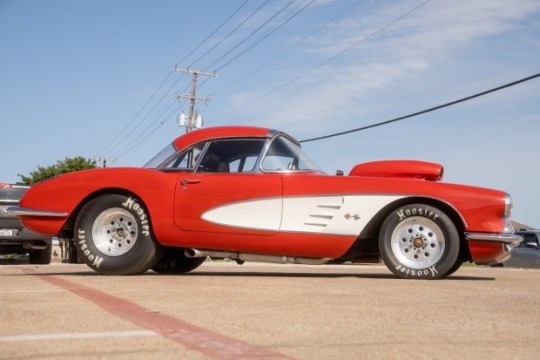
1958 Chevrolet Corvette
The fiberglass exterior is adorned in red with white coves and includes a removable hardtop and a lift-off hood with an integrated air scoop. A Stewart-Warner fuel-pressure gauge is mounted on the cowl, and the right-rear corner features a battery cutoff switch and external terminals. The gallery reveals cracks in the weatherstripping, pitted chrome, and paint imperfections.
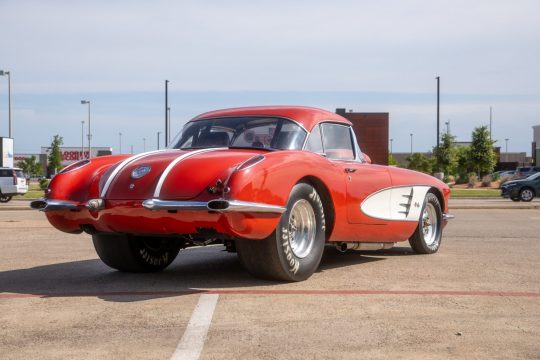
1958 Chevrolet Corvette
Polished 15” alloy wheels are shod with 25.0×5.0” front and 29.5×11.5” rear Hoosier drag tires, installed in April 2024. A crossmember supports the rear suspension, which has been modified with ladder bars, a diagonal link, and adjustable coilovers. The braking system includes front disc brakes and rear drums.
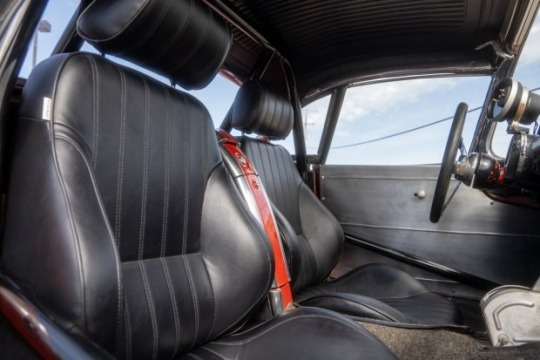
1958 Chevrolet Corvette
The interior is equipped with a roll cage and Procar high-back bucket seats in black. Enhancements include a B&M Pro Stick shifter, an MSD shift light, rocker-switch controls, and fabricated metal door panels. The gallery displays flaking paint and wear on interior surfaces.

1958 Chevrolet Corvette
The three-spoke steering wheel is positioned in front of a 160-mph speedometer and auxiliary gauges. An AutoMeter pedestal tachometer is mounted atop the non-functional factory tachometer. Additional gauges for coolant temperature and oil pressure are located in the center console. The mechanical odometer is inoperative, and the total mileage remains unknown.
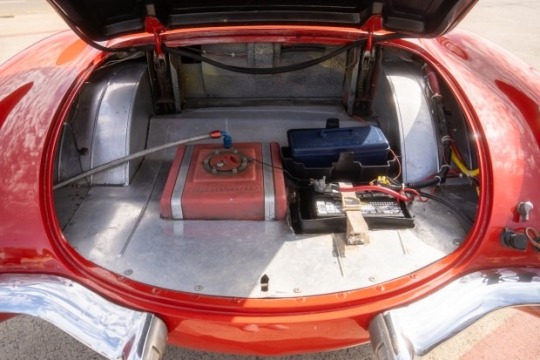
1958 Chevrolet Corvette
A Harwood plastic fuel cell is mounted in the trunk, which has been tubbed with fabricated aluminum panels to accommodate the rear wheels.

1958 Chevrolet Corvette
The 350ci V8 engine block, bored and stroked to 383ci, features four-bolt main bearings. The build includes forged pistons, ARP fasteners, a polished Edelbrock intake manifold, dual Edelbrock carburetors, an MSD ignition module, and Hooker long-tube headers that flow into side-exit exhaust pipes.
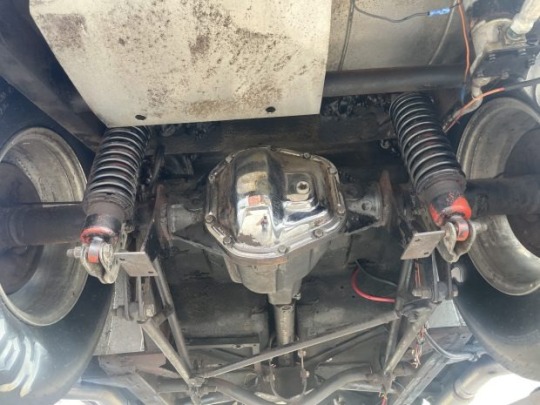
1958 Chevrolet Corvette
Power is transmitted to the rear wheels through a TH350 three-speed automatic transmission and a narrowed Dana 60 rear axle with a limited-slip differential.

1958 Chevrolet Corvette
141 notes
·
View notes
Text
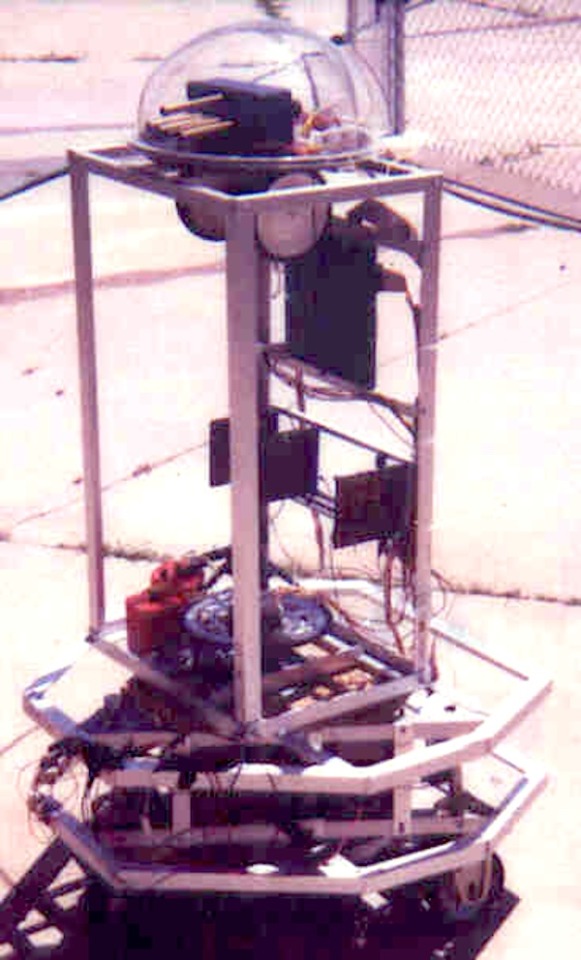
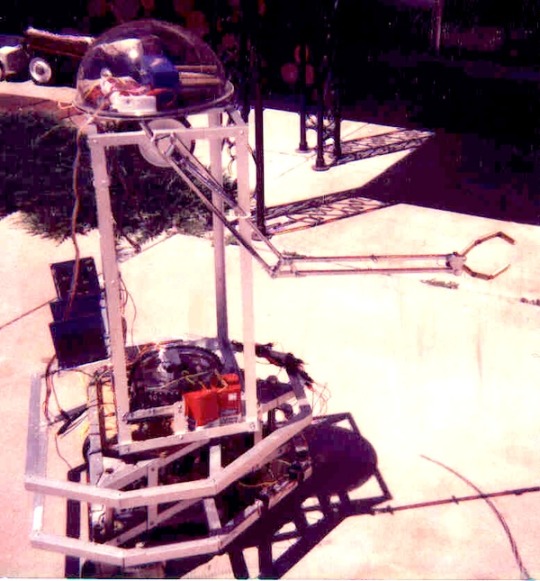
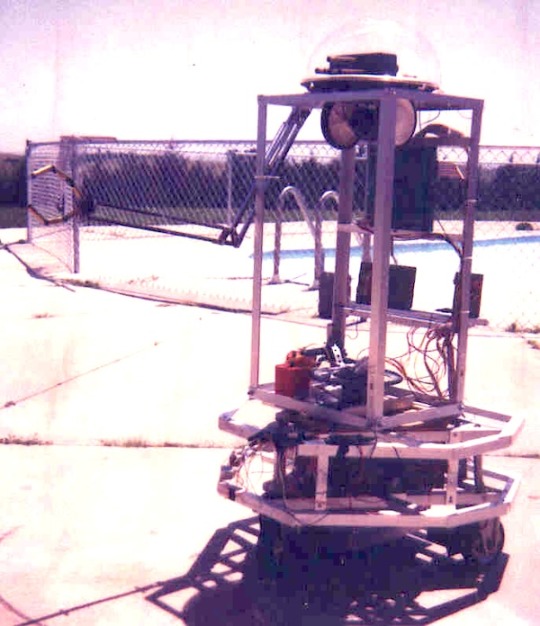
S.A.M by "Bill" (1978). "S.A.M (Short for "Sentient, Autonomous Mechanism" or "Smart Ass Machine", depending on his (and my) mood on a given day, was one of my first real robot projects, started in 1978 when I was around 15. His "brain" was a single-board Z-80 computer (the big square object in the middle of his "back" in this picture), with many bits of TTL I/O, a couple of serial ports, a bunch of counter-timers, and several D/A & A/D channels. The base was taken from the book "How to Build a Computer Controlled Robot" by Todd Loofbourrow - I had built the robot in the book, and had used my KIM-1 to control it. Later, I decided that just a little platform was kind of boring, so I added the upper torso shown here. The torso (mounted on a "lazy-susan" turntable bearing) is rotated by a heavy-duty gear motor driving a chain and sprocket assembly from a bicycle. The base is powered by two of the (apparently no longer available, which is sad) all-metal rubber-tired "motorized wheel" assemblies that Herbach & Rademan used to sell, with a large rubber-tired caster in front. The head platform (mounted on a small "lazy-susan" bearing) was originally rotated by a surplus gearbox from a Mattel "Big Trak" with some rubber-tired wheels mounted on the output shafts. This arrangement was later replaced by a small gear-head motor driving a large gear mounted to the center of the turntable. The device in the head with the tubes sticking out the front is a directional light tracking device. Each tube has a CDS photocell at the bottom, and is painted flat black inside. A comparator circuit tells the computer which direction the brightest light is coming from. This device could also tilt up and down with a small gear-head motor, to track light sources vertically. Most of the circuitry was installed on small plug-boards from Radio Shack, mounted in a card rack below the CPU card. This rack could be tipped back 90 degrees to facilitate easier access for testing. In addition to motor driver circuits, there was a "Sweet Talker" speech synthesizer board so he could talk. Power came from a large "gel-cell" marine battery (for powering trolling motors on boats), which was slung near the ground in the center of the base. Two 6V lantern batteries (later replaced by a 12V motorcycle battery) provided separate power for the electronics. All motors were isolated from the electronics via relays and/or opto-isolators. After these pictures were taken, a set of metal panels was installed on the "facets" of the base, with lever switches behind them for collision sensing. A Polaroid sonar range-finder was also added later. If you check out the other photos of S.A.M., you will notice an "arm" sticking out the front. This was a prototype made from an old swing-arm desk lamp and some "fingers" from a robot hand design using brass tubing, bicycle chain, and 1/16" steel cable to allow natural bending of each finger. It was later replaced with a much heavier duty aluminum framework arm operated by two 12VDC linear actuators." – My Home Robot Projects, by Bill.
24 notes
·
View notes
Text
Trinity, Pt. 2
Next, we find the team inside the Ancient facility that seemed to be the source of the energy reading McKay got from the planet. Teyla is the last one to come down the ladder where McKay, Sheppard and Ronon are already down in the dark room with their flashlights. We do not see who came down first, and while McKay definitely seems excited enough to have wanted to come down first, it is extremely doubtful Sheppard would have allowed him to do that. Given that Ronon only switches his flashlight on after Teyla has descended and Sheppard is using the light on his P-90, we can deduce that it was likely Sheppard himself that had come down first, using his weapon to light the way. This is also symbolic of the role of the military in scientific advancement, given that they are in an Ancient military laboratory.
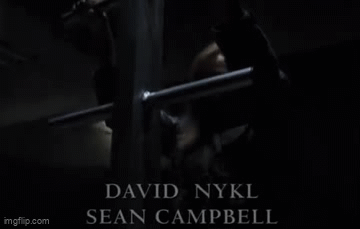
McKay: Definitely Ancient design. Their latest stuff, too.
As McKay is blowing 10,000 years of dust off of a panel, we see Sheppard in the background holding his hand over another panel apparently trying to switch it on with his Ancient gene. He must been doing it on Atlantis often enough that he expects it to work here, as well. He recognizes the technology as Ancient just as easily as McKay does. But he does not just recognize the technology as Ancient, he recognizes it as a lab which again witnesses to the amount of time the two of them have spent together.

McKay: Their latest being ten thousand years old. Sheppard: Looks a lot like the labs we found on Atlantis. Dex: So this is one of their outposts. Teyla: Yet the Ancestors made no mention of their presence here in the database. Why?
Teyla is again the first one to ask the relevant question, McKay and Sheppard too preoccupied by the possibilities to have been able to process any of the implications yet, and Ronon is clearly just simply overwhelmed by the Ancients being a tangible, real thing instead of something out of the legends. But we are again able to see them working together as a team here, with all of them having their own roles, strengths and even interests. McKay is the how person, Sheppard is the why person, Ronon is the what person and Teyla, even though she explicitly asks the 'why?' question here, is usually the who person. She poses the question why because she is interested in the who, the Ancestors and the original inhabitants of the planet, the Dorandans.
Eager to figure out the mystery himself, Sheppard urges McKay to get them some power going:

Sheppard: Well, let's find out. Can you power it up? McKay: Working on it.
This too is relevant for why things play out the way they do. While Sheppard poses this as a question, he seems to expect McKay to be able to do this. He may not be telling McKay what to do, and he certainly does not order him to do it, but nevertheless there is an expectation that McKay will be able to deliver. He relies on McKay's technical expertise and because McKay has been consistently able to deliver, is frequently able to perform smaller and larger miracles, it has practically become the baseline for his ability. Sheppard has such an unwavering trust and faith in McKay's abilities that he fails to recognize how this translates into an unspoken expectation, which in turn translates into pressure put on McKay's shoulders. And it is possible McKay does not himself recognize this consistently mounting pressure at this time, but it certainly is increasing. Adding on. Piling up. And as performing acts of service is how he seeks validation, there is a recipe for disaster brewing here.

Sheppard: I got two bodies here.
And speaking of disaster, one seems to have occurred in the facility and there is perhaps something symbolic in the fact that Sheppard is the one to come across the bodies of two Ancients that seem to have died under curious circumstances, as they are laying on their backs and their feet are touching. We do not know what these two people were to each other when they were alive, but they certainly are together in death.
Their deaths must have been instantaneous and occurred with no warning. Ronon comes across additional bodies in an adjacent chamber, and he makes an observation about the dead having been abandoned here. While none of the others can see it, this seems to give McKay pause. He actually stops what he is doing to think about it.

Dex: I got three more over here. Whatever happened here, no-one came back to claim the dead.
We know that there was nothing left of Peter Grodin's body to retrieve after he had been blown up by the wraith on the Ancient satellite but we never did find out what happened to the bodies of Dr. Abrams and Dr. Gaul of The Defiant One (S01E12), both of whose deaths McKay had likewise been unable to prevent and the latter of whom took his own life right before McKay's eyes. Did they ever retrieve their bodies or were they just left on the planet? And yet being able to retrieve the bodies from labs just like this one of Drs. Wagner, Johnson, Dumais and Hays in Hot Zone (S01E13), during the events of which Sheppard had also been forced to shoot Dr. Peterson, had not really made him feel any better about having lost them. McKay had further been unable to keep Drs. Monroe and Lindström from being killed by the wraith virus in The Intruder (S02E02). All of these people had worked under him, most of these people he probably had selected for the mission personally.
The bodies kept piling up, and it was so few of them that he had been able to send back to their families and loved ones back to Earth. There had been no one to claim the bodies but himself. He was responsible for all of their deaths. He looks haunted here, for a brief moment. Haunted by all of the deaths that happened on his watch. And given that he feels alone now, estranged as he is from his sister, having cut all ties back to Earth (like he told Cadman in Duet (S02E04), he has no intention of returning to Earth), his cat had probably died while they were away, and somewhere along the way he had also lost Sheppard, which was still fresh and hurt most of all.
He was alone. He felt lonely. If he died, there was no one that would care what happened to his body. Maybe he would be left rotting on the floor of some Ancient lab somewhere in this galaxy far, far away from Earth. He had once thought that he might even have found a home here, in these people that had become something like a surrogate family to him. How wrong he had been. A cold and lonely death was all that was waiting for him, in a cold and lonely grave, if he was so lucky to even get a grave. These people had no graves because no one had come to claim them, like Ronon had just pointed out. McKay looks up for the briefest moment, and yet all of this we can see in that one look.
And in the next moment, it is gone, and none of the others are there to see it. They are too busy trying to figure out the mystery to spare a thought for him. And McKay does what he has always done: he loses himself in the work. He gets back to trying to get Sheppard that power he wanted. He is twice as determined to figure out how to get that to happen. As long as he is fiddling with the Ancient control panel, he does not have to remember all the bodies he carries in his heart.

Sheppard: Can't tell if they were fed on by the wraith. Dex: Yeah, something killed them. Teyla: Something killed everyone on this world. Sheppard: Now why is this outpost, if that's what it is, still intact? Doesn't make sense.
Sheppard is kneeling by the bodies of the dead (lovers?), trying to suss out what had happened to them. As much as he appreciates that Ronon and Teyla are there with him, trying to figure this thing out, it has clearly been too long since he has heard from McKay, as he feels the need to touch base with him again. He needs to know what McKay makes out of all of this. And note that now, as he is again distracted by this mystery unfolding around them and not trying to keep a distance, he slips back into calling him with the more intimate address:

Sheppard: What do you think, Rodney? McKay: Ha! Sorry, I wasn't listening, but it just struck me that, if this is an Ancient outpost, why would the wraith leave it intact? Sheppard: ...It's a good question. McKay: Huh. Alright, so...
This is again played for comedy. McKay is not paying attention and says essentially the same thing as Sheppard, who then congratulates him on arriving on the exact same conclusion he did. As though this is meant to underscore the fact that Sheppard is also intelligent, perhaps even to remind us of the fact that Sheppard is occasionally faster than he is. But the thing is, even though the questions they pose have the same words in them, they are not the same question. The emphasis of the questions is different. Sheppard is curious about the present state of the facility and what lead to it. McKay is thinking about the wraith and their motivations. And Sheppard does honestly find that a good question, and it is also one that he as the military commander in charge of their struggle against the wraith should have been asking. They also stress different things. Sheppard puts stress on the word 'intact' where McKay puts emphasis on the word 'Ancient'. Sheppard is thinking about the base, McKay is thinking about the war. Sheppard is grounded in the present where McKay, even though his question is based in history, is actually future-oriented here.
But given their ability to read each other's thoughts from the minutest of cues that we have witnessed, this is probably also meant to underline their mental connection, how similar they are in thought and how they are able to work as one mind, one person. Their thinking is similar enough to facilitate this connection between them, and they do look each other in the eye here for a considerably long time. Something does seem to be communicated between them, enough that both Ronon and Teyla notice it and they both turn away from the two of them as though to give them a private moment here.

But then they both lower their eyes, and they both seem a little lost here. It is possible that Sheppard was hurt by the fact that McKay did not appear to be listening to him, and it is possible McKay was unsure of how to read Sheppard's comment, of whether he actually meant that it had been a good question or whether it had been sarcasm. McKay is not used to receiving praise from Sheppard, because although Sheppard thinks the world of McKay, he is not really a positive re-enforcement kind of guy. Even when he does give praise, it is often couched in sarcasm or flippancy, something to take the edge off and make it seem like not such a big deal.
Giving honest praise without wisecracking requires emotional earnestness of which Sheppard is in short supply. And hence, while a part of McKay is pleased that Sheppard would call his question a good question, another part of him is playing it down, convinced that he meant that it was a stupid question. And a part of the audience might see it like that too. Furthermore, the comedic beat of this exchange masks McKay's earlier haunted look, helping us forget that McKay is anything but a comic relief character. That is how good McKay is at hiding his pain.
Some time later, the team have returned to Atlantis and are filling Weir in on the discovery. Noteworthy here is that Sheppard and McKay are presenting it as one mind again, Sheppard using the 'we' form and both of them tag-teaming the explanation to her. Sheppard seems to be just as excited about it as McKay is. Sheppard also turns his body toward McKay as he speaks.

Weir: So it's a military research facility. Sheppard: From what we can tell, it's a ground-based version of the satellite weapon we used to destroy that hive ship. McKay: With one major exception. Firepower.
This is important and I have not seen it discussed previously. Sheppard references the LaGrange Point satellite here, featured in The Defiant One (S01E12) and The Siege (S01E19). While he does not mention it by name, that is what he is referring to. And what happens in this episode has everything to do with what happened on the satellite platform that Sheppard had meant to accompany McKay on but had been ordered by Weir not to. It has everything to do with Peter Grodin and McKay's inability to save him, with McKay blaming himself for Grodin's death because he had failed to fix the satellite. The satellite had been able to fire only once because the patch that he had been able to put together was only a temporary fix, and the wraith had destroyed the satellite with Grodin on it. Grodin, who had been important to McKay personally, whether or not you believe that they had been previously involved. It is against this backdrop (not to forget all the other scientists that have died under his watch) that we must interpret what happens in this episode, and that is why they mention it right here at the offset.
Sheppard says "we" here, doing what we have seen McKay do previously, trying to alleviate some of the guilt McKay is feeling by taking a portion of the blame. We have seen McKay take his share of the blame of waking the wraith e.g., in Poisoning the Well (S01E06). But while that is what he attempts to do, McKay can share the success of having managed to take out the hive, but he will not share the blame of failing to save Grodin. That is his failure and his alone. That is a loss that he has to live with every day of his life, and he is far from being over it. And again you cannot even hear it in his voice as he waxes poetic about the firepower of this new weapons platform but you had better believe that he remembers it. And, given that we later learn about McKay and Sheppard having discussed who talks about what to whom, they may even have agreed that Sheppard will be the one to talk about the connections of this new facility to the satellite because he just cannot bring himself to talk about it anymore than Sheppard can bring himself to talk about having roused the wraith. They are presenting this to her very much together.

McKay: I mean, if that single outpost was responsible for destroying an entire wraith fleet... Weir: And you're sure it was this weapon that destroyed all those wraith ships? Sheppard: It had to be. There's nothing on the planet that suggests the Dorandans had anything capable of inflicting anywhere near that much damage.
Note that Sheppard and McKay enter through the same doorway (the door between Sheppard and Weir; there are some possibly pseudo-psychological studies about people in love rounding objects on the same side so as to avoid having anything between them) to the conference room here and like they used to do, they almost try to enter it at the same time. McKay is very much in Sheppard's personal space and Sheppard's hand is definitely in McKay's space.

Teyla: If we could learn of such technology, we could defend other worlds from being culled. Dex: It didn't save the Dorandans. McKay: Yeah, but at the end of the day the outpost was still standing and that means... Well, I'm not sure what that means, but it means something definitely worth finding out. Weir: Colonel? Sheppard: He's right. It's definitely worth sending a research team back.
Sheppard looks anguished here. We should recall that it had been Sheppard's choice not to accompany McKay to the satellite platform that he believed had lead to McKay's death, and that pain that he had felt before he learned that McKay had survived the wraith destroying the satellite had been the worst pain of his life, pain unlike he had ever felt before. Something like that is not easy to forget, and the fact that McKay had survived it did not erase the fact that he had experienced the pain. He knows what it feels like now, losing McKay. Before he had left for the platform, McKay had put together a team and was in want of a pilot, hoping Sheppard would accompany them. And Sheppard had volunteered for the mission. He had wanted to be a part of the mission. And even now, it seems like Sheppard probably wanted to be a part of this team. But McKay seems to have other ideas.

McKay: Good! Well, give me Optican, Collins, and Zelenka if he's over the stomach flu. We'll try to access the computer's log books, see if we can decipher them. Once that's-- Weir: OK! OK! Easy sell. Go. McKay: Oh, good!
Now, Sheppard opens his mouth and almost says something to Weir as McKay mentions Zelenka's stomach flu which is interesting in the light of their earlier discussion about Ronon having a strong stomach and McKay being able to eat frozen dinners unthawed. There might be a bug going around the base and their earlier discussion may have had its genesis in that. Could be that Sheppard simply does not "like gross things," like people often say, or he was going to wisecrack about it but then thought better of it. He nearly says something but then decides against it. But it is also possible that Sheppard hadn't meant to interject anything about the stomach flu but was going to say something about McKay's choice of team. He might have been about to say that he very much wanted to insert himself into it, to protest not having him on it, to somehow make sure that this would not be a repeat of the previous mission, but McKay's mention of the stomach flu just short-circuited his brain. And as we see later, Sheppard was not going to let four scientists go back on the alien weapons platform without him. After the last time, he is not taking any chances.
Note also at the end that Sheppard first turns to watch McKay go, as one frequently does for someone they care about, but then he looks at Weir and smiles while tilting his head, and this expression is all about the fondness he feels for McKay. It has this "Got to love him, huh?" energy about it, like he just felt the need to share his fondness for McKay with someone that might appreciate it, or someone that would at least understand since Weir does know about them. It has been a while since he has seen McKay this happy and full of life. When he is like this, McKay is like a force of nature. That is the man that he loves.
Continued in Pt. 3
#sga#stargate atlantis#john sheppard#sga meta#sheppard is bi#rodney mckay#rodney is gay#ep. trinity#ep. the defiant one#ep. the siege#ep. hot zone#ep. the intruder#ep. duet#ep. poisoning the well#mcshep
8 notes
·
View notes
Text
In a future conflict, American troops will direct the newest war machines not with sprawling control panels or sci-fi-inspired touchscreens, but controls familiar to anyone who grew up with an Xbox or PlayStation in their home.
Over the past several years, the US Defense Department has been gradually integrating what appear to be variants of the Freedom of Movement Control Unit (FMCU) handsets as the primary control units for a variety of advanced weapons systems, according to publicly available imagery published to the department’s Defense Visual Information Distribution System media hub.
Those systems include the new Navy Marine Corps Expeditionary Ship Interdiction System (NMESIS) launcher, a Joint Light Tactical Vehicle–based anti-ship missile system designed to fire the new Naval Strike Missile that’s essential to the Marine Corps’ plans for a notional future war with China in the Indo-Pacific; the Army’s new Maneuver-Short Range Air Defense (M-SHORAD) system that, bristling with FIM-92 Stinger and AGM-114 Hellfire missiles and a 30-mm chain gun mounted on a Stryker infantry fighting vehicle, is seen as a critical anti-air capability in a potential clash with Russia in Eastern Europe; the Air Force’s MRAP-based Recovery of Air Bases Denied by Ordnance (RADBO) truck that uses a laser to clear away improvised explosive devices and other unexploded munitions; and the Humvee-mounted High Energy Laser-Expeditionary (HELEX) laser weapon system currently undergoing testing by the Marine Corps.
The FMCU has also been employed on a variety of experimental unmanned vehicles, and according to a 2023 Navy contract, the system will be integral to the operation of the AN/SAY-3A Electro-Optic Sensor System (or “I-Stalker”) that’s designed to help the service’s future Constellation-class guided-missile frigates track and engage incoming threats.
Produced since 2008 by Measurement Systems Inc. (MSI), a subsidiary of British defense contractor Ultra that specializes in human-machine interfaces, the FMCU offers a similar form factor to the standard Xbox or PlayStation controller but with a ruggedized design intended to safeguard its sensitive electronics against whatever hostile environs American service members may find themselves in. A longtime developer of joysticks used on various US naval systems and aircraft, MSI has served as a subcontractor to major defense “primes” like General Atomics, Boeing, Lockheed Martin, and BAE Systems to provide the handheld control units for “various aircraft and vehicle programs,” according to information compiled by federal contracting software GovTribe.
“With the foresight to recognize the form factor that would be most accessible to today’s warfighters, [Ultra] has continued to make the FMCU one of the most highly configurable and powerful controllers available today,” according to Ultra. (The company did not respond to multiple requests for comment from WIRED.)
The endlessly customizable FMCU isn’t totally new technology: According to Ultra, the system has been in use since at least 2010 to operate the now-sundowned Navy’s MQ-8 Fire Scout unmanned autonomous helicopter and the Ground Based Operational Surveillance System (GBOSS) that the Army and Marine Corps have both employed throughout the global war on terror. But the recent proliferation of the handset across sophisticated new weapon platforms reflects a growing trend in the US military towards controls that aren’t just uniquely tactile or ergonomic in their operation, but inherently familiar to the next generation of potential warfighters before they ever even sign up to serve.
“For RADBO, the operators are generally a much younger audience,” an Air Force spokesman tells WIRED. “Therefore, utilizing a PlayStation or Xbox type of controller such as the FMCU seems to be a natural transition for the gaming generation.”
Indeed, that the US military is adopting specially built video-game-style controllers may appear unsurprising: The various service branches have long experimented with commercial off-the-shelf console handsets for operating novel systems. The Army and Marine Corps have for more than a decade used Xbox controllers to operate small unmanned vehicles, from ground units employed for explosive ordnance disposal to airborne drones, as well as larger assets like the M1075 Palletized Loading System logistics vehicle. Meanwhile, the “photonics mast” that has replaced the traditional periscope on the Navy’s new Virginia-class submarines uses the same inexpensive Xbox handset, as does the service’s Multifunctional Automated Repair System robot that’s employed on surface warships to address everything from in-theater battle damage repair to shipyard maintenance.
This trend is also prevalent among defense industry players angling for fresh Pentagon contracts: Look no further than the LOCUST Laser Weapon System developed by BlueHalo for use as the Army’s Palletized-High Energy Laser (P-HEL) system, which explicitly uses an Xbox controller to help soldiers target incoming drones and burn them out of the sky—not unlike the service’s previous ventures into laser weapons.
"By 2006, games like Halo were dominant in the military," Tom Phelps, then a product director at iRobot, told Business Insider in 2013 of the company’s adoption of a standard Xbox controller for its PackBot IED disposal robot. "So we worked with the military to socialize and standardize the concept … It was considered a very strong success, younger soldiers with a lot of gaming experience were able to adapt quickly."
Commercial video game handsets have also proven popular beyond the ranks of the US military, from the British Army’s remote-controlled Polaris MRZR all-terrain vehicle to Israel Aerospace Industries’ Carmel battle tank, the latter of which had its controls developed with feedback from teenage gamers who reportedly eschewed the traditional fighter jet-style joystick in favor of a standard video game handset. More recently, Ukrainian troops have used PlayStation controllers and Steam Decks to direct armed unmanned drones and machine gun turrets against invading Russian forces. And these controllers have unusual non-military applications as well: Most infamously, the OceanGate submarine that suffered a catastrophic implosion during a dive to the wreck of the Titanic in June 2023 was operated with a version of a Logitech F710 controller, as CBS News reported at the time.
“They are far more willing to experiment, they are much less afraid of technology … It comes to them naturally,” Israeli Defense Forces colonel Udi Tzur told The Washington Post in 2020 of optimizing the Carmel tank’s controls for younger operators. “It’s not exactly like playing Fortnite, but something like that, and amazingly they bring their skills to operational effectiveness in no time. I’ll tell you the truth, I didn’t think it could be reached so quickly.”
There are clear advantages to using cheap video-game-style controllers to operate advanced military weapons systems. The first is a matter of, well, control: Not only are video game handsets more ergonomic, but the configuration of buttons and joysticks offers tactile feedback not generally available from, say, one of the US military’s now-ubiquitous touchscreens. The Navy in particular learned this the hard way following the 2017 collision between the Arleigh Burke-class destroyer USS John S. McCain and an oil tanker off the coast of Singapore, an incident that prompted the service to swap out its bridge touchscreens for mechanical throttles across its guided-missile destroyer fleet after a National Transportation Safety Board report on the accident noted that sailors preferred the latter because “they provide[d] both immediate and tactile feedback to the operator.” Sure, a US service member may not operate an Xbox controller with a “rumble” feature, but the configuration of video-game-style controllers like the FMCU does offer significant tactile (and tactical) advantages over dynamic touchscreens, a conclusion several studies appear to reinforce.
But the real advantage of video-game-style controllers for the Pentagon is, as military officials and defense contractors have noted, their familiarity to the average US service member. As of 2024, more than 190.6 million Americans of all ages, or roughly 61 percent of the country, played video games, according to an annual report from the Entertainment Software Association trade group, while data from the Pew Research Center published in May indicates that 85 percent of American teenagers say they play video games, with 41 percent reporting that they play daily.
In terms of specific video games systems, the ESA report indicates that consoles and their distinctive controllers reign supreme among Gen Z and Gen Alpha—both demographic groups that stand to eventually end up fighting in America’s next big war. The Pentagon is, in the words of military technologist Peter W. Singer, “free-riding” off a video game industry that has spent decades training Americans on a familiar set of controls and ergonomics that, at least since the PlayStation introduced elongated grips in the 1990s, have been standard among most game systems for years (with apologies to the Wii remote that the Army eyed for bomb-disposal robots nearly two decades ago).
“The gaming companies spent millions of dollars developing an optimal, intuitive, easy-to-learn user interface, and then they went and spent years training up the user base for the US military on how to use that interface,” Singer said in a March 2023 interview. “These designs aren’t happenstance, and the same pool they’re pulling from for their customer base, the military is pulling from … and the training is basically already done.”
At the moment, it’s unclear how exactly many US military systems use the FMCU. When reached for comment, the Pentagon confirmed the use of the system on the NMESIS, M-SHORAD, and RADBO weapons platforms and referred WIRED to the individual service branches for additional details. The Marine Corps confirmed the handset’s use with the GBOSS, while the Air Force again confirmed the same for the RADBO. The Navy stated that the service does not currently use the FMCU with any existing systems; the Army did not respond to requests for comment.
How far the FMCU and its commercial off-the-shelf variants will spread throughout the ranks of the US military remains to be seen. But controls that effectively translate human inputs into machine movement tend to persist for decades after their introduction: After all, the joystick (or “control column,” in military parlance) has been a fixture of military aviation since its inception. Here’s just hoping that the Pentagon hasn’t moved on to the Power Glove by the time the next big war rolls around.
6 notes
·
View notes
Text
Valiant
(Original post, Chapter 1)
Chapter 2
"Ellie!"
I blink awake. It's dark, the lighting hasn't switched over to morning mode yet and the sky is still black through the warehouse skylights. In fact, the only light is the gentle blue-white from Val's core. The indicator lights from the diagnostic equipment I have set up are completely dark.
I feel a spike of panic. A black out could mean any number of things, from benign to literal end of the world.
"What's going on?" I ask, fighting my grogginess. "What time is it?"
"I have lost external network connection. My internal clock indicates that it is 2:36:74," she says. Her voice is tinny and distant, likely the embedded speaker that I've managed to patch up.
"Ellie, I am sorry," she says. Her tone is distressed and contrite. She continues in a rush, "local wildlife nested amidst the network antenna and I attempted to relocate the nest. However in the process, I have accidently shorted the main high power bus with my drone peripheral."
Ah. That explains that. She probably tripped the main breaker. It's a terrible design and I've been meaning to add some resiliency, but that keeps getting out prioritized.
"Ellie, I am sorry," she repeats. "I have committed a mistake and I have inconvenienced you."
What?
Oh…
She's having the equivalent of a panic attack. She is a hyper intelligent AI core designed for fleet coordination and battle modeling, where failure to follow orders and standard operating procedure costs lives. This comes with a lot of built in anxiety. I understand that modern starships are less prone to such things, but when she was commissioned, the goal was to produce many warships very quickly. They were ultimately meant to be disposable, which led to some programming shortcuts.
"Hey," I say softly. "Are you okay? That's all I care about right now."
I roll out of my hammock and press my body against the surface of her core so that she can feel the plasmic discharge induced by my contact.
"I am well," she replies, her voice still small and panicked. "My core is isolated from main power. I can provide full diagnostics if you desire."
"No, that's okay. I'm glad you're alright. Should we see what we can do to take care of this?"
"Yes, please…"
She pauses.
"I do not like being disconnected. I… do not like the dark."
My heart breaks a little. Eighty-seven years, that's how long she was alone before I found her. An AI like hers can enter low power mode, but that is still an unfathomably long time. Units like her were never meant to be alone.
I reluctantly disengage from her core.
"I have to go outside," I tell her. She knows this, but I'm hoping it helps to talk through the process. "I'm going to get the headset working, so I'll be able to stay in contact, okay?"
"Thank you"
I pat the surface of her core gently before checking the rf transmitter I rigged up at her access port. It's short range, but it runs on her internal power. We used it a lot before I got her connected to internal and external networks, pretty much for this exact purpose, so I could talk to her without being right next to the core.
Connection looks good. I slip on the ear piece.
"Hey, can you hear me?"
"Yes, I can hear you Ellie," she replies.
Her voice through the earpiece is warm and smooth, even under the panic. It's her chosen choice and… well, it makes me feel… okay, I'll just say it, it's a very sexy voice. The speaker mounted on the access panel doesn't really convey the full timbre of it. Needless to say, I was blown away the first time I heard it in high fidelity.
I think I might be in love with her.
There's a lot to unpack there, but there's no point in denying that the feelings exist.
I throw on a sweater and a spare pair of boots and make my way up the scaffolding that leads to roof access. About halfway there, I pause for a moment to catch my breath. I chance a look down and my breath is stolen from me.
This room, this entire building, is a warehouse built for a machine of war to be abandoned and forgotten.
It's a squat for a scavenger trying to eke out an existence on the fringes.
"You're beautiful," I whisper.
It is a cathedral. It is a temple built for a goddess and her priestess.
Here in the dark, lit only by the radiation of her core, the space seems infinite.
Her core flickers in response, but she doesn't say anything. She might be embarrassed. She might never have heard those words before and doesn't know how to respond. She doesn't need to. I don't know if she feels the same about me. I'm not even sure if I should want her to. I would hate for her to feel obligated to return my affection solely by the fact that I am the only one who cares enough to repair her. I started this project because I couldn't bear the thought of her suffering alone in darkness, any romantic feelings I have are incidental... mostly.
I continue my scent and finally arrive at the roof access. The door opens with a squeal and I step into the frigid night.
"Oh!" I gasp.
"Ellie?" Val asks in my ear after a moment, worry creeping into her voice. "Are you well?"
"Oh, sorry…" I reply. "It's the stars. The high altitude haze from that dust storm last week has finally cleared. It's… spectacular."
There's a pause.
"Would you describe them for me?" she asks plaintively.
"Uh, sure… but I'm not sure if I can do it justice. Well, there's the glow from the industrial district, but it's not too bad tonight. We've got the arc of the Milky Way pretty much directly overhead. And there's like the fuzzy haze of the planetary disk. Looks like one of the ice giants too. And… well, stars. Thousands of them, just crystal clear."
I locate the main antenna and, sure enough, the drone is tangled up with the main power lines. It looks like there might have been some thin insulation that arced. The spidery drone itself might be salvageable. It is clutching an unfortunately empty nest in its manipulators, whatever wildlife must have fled when she disturbed it. The drone's head is tilted curiously back in a way that I don't think it's fully explainable by arcing.
"Wait, were you out here stargazing?
"The ocular system on the drone peripheral lacks the resolution and focal length to resolve individual stars."
It's not an answer and she sounds very vaguely guilty.
"It's alright if you were," I tell her as I bend down to examine the power conduits. "And I can see if I can get you a better camera system up here. Maybe something telescopic."
"I would not want to inconvenience you," she replies.
"Val, you're allowed to want things," I sigh.
She's quiet for a long moment while I move the drone and begin repairs on the power conduit.
"I miss the stars," she says finally. "There are many things I wish to forget about my past. Being alone amidst the stars was one of my few comforts."
I consider this. It's the most she's ever told me about her past. I've seen the diagnostic logs of her positronic activity indicating distress. Her equivalent of nightmares.
"You know any good stories about them?" I ask.
"I do not understand the nature of your query."
"I don't know," I say with a shrug. "I guess I'm just curious if you have any favorites or if you have any interesting facts in your database.
I'm not really sure how I expect her to respond. I just want to get her talking and not dwell on being trapped in the dark or feeling guilty about causing it.
"There is a star," she begins tentatively, "which according to local charts and my estimate of local time, should be located at azimuth 146.7, elevation 25.4. It is the brightest star in the southern sky, do you see it?"
I'm honestly surprised by this, and it takes me a minute to orient myself and find it.
"Yeah, the bright blue one?"
"Yes!" she replies, and as she speaks she gets more animated - her tone brightens and her cadence picks up. "Epsilon Orionis, Hipparcos 26311, also known as Alnilam. It is the central star of the asterism as viewed from Earth known as Orion's belt. It is among the brightest stars visible from this region of space. During first wave colonization, it was erroneously back translated to Al-Nilam, the Sapphire. Local neo-folkloric tradition associates it with either a maiden or queen…"
She continues on like that, and I find myself absolutely fascinated as I work. The detail is very encyclopedic, but there are aspects of it that she can't possibly have obtained from just a star chart. I quickly come to the realization that she must have sought out details about the folklore and mythology on her own.
This was a hobby of hers. There's no question in my mind now that I have to obtain a better system to facilitate her stargazing.
I finish the patch job on the conduit and heft the drone over my shoulder while she continues. I only interrupt her when I arrive back at the high power breaker.
The night lighting comes back up and she practically sighs with relief as she reconnects with the external network. I wearily drag myself back to my hammock.
"Ellie, I'm sorry to have woken you and taken up so much of your time," she says.
I sigh and press my hand to the surface of her core.
"It's okay, really," I tell her. "I'm here for you."
"Thank you for listening to me," she says, bringing a smile to my face.
"Goodnight, Val."
"Goodnight, Ellie."
I almost say "I love you". I want to.
41 notes
·
View notes
Text
Been sick for the past week, so I haven't got a Marine Meat Monday short to post. Instead, here's a snippet from the middle of a longer story I'm working on.
Apologies for the lack of meat, but I thought it might be appropriate since it focuses on... A marine's body? I guess?
Okay, you got me, this is about Captain Drakgaard of the 6th Company becoming a Dreadnought.
This is an early draft, so polite feedback is welcome and appreciated. 💚
Drowning in an ocean of perfluorocarbon emulsion, floating on a sea of drugs, Drakgaard had slipped back in time beyond Captainship, beyond ascension, beyond birth. He floated alone in a steel womb, hooked to it by cables he couldn't feel. These cables sustained him, changed him, began to mold him into something new. He wasn't conscious of the machine spirit that floated with him, also asleep. As the song of power was sung and the reactor was switched on, the spirit awoke. It climbed through the cables as the techpriests outside chanted the litanies Drakgaard had found tiresome in life. For a moment, it paused, finding its inhabitant changed. Then, the words in binharic reached it as the priests sang of the life of its new inhabitant. It was an ancient machine spirit, they sang, and the man within was an ancient Brother. They bid it to accept him, to become one with him as it had with its previous inhabitants. As they sang, a host of servitors’ fingers click-clacked against keyboards, their broken, half-rotten mouths droning twisted echoes of the priests’ songs.
A shot of adrenaline administered by Apothecary Sepelius roused the man within. He felt weightless, then was not sure where the edges of his self lay. He tried to move and no motion was possible. The pain he had felt when he had briefly awakened after the necessary amputations was gone. The scarred, branded, and finally broken body he had lived in for almost half a century was out of his reach.
In that second, he realized where he was. What he was. He had agreed to this in the presence of his Sergeants, Apothecaries and Techpriests. As he consented, Chaplain Elysius, the man who had saved his life, had lowered his eyes and murmured, “Duty and salvation.” There would be no Burning Walk for Ur'zan Drakgaard, and neither would there be the Emperor's Mercy.
The machine spirit was here with him now. He could hear it greeting him in a wordless voice that was somehow his own. This would be his afterlife, if he accepted it.
For a moment, he resisted. He would not be himself if he didn't rage against the dying of the light, would he? But then, duty called. As the voices outside grew louder, Drakgaard closed his physical eyes for the last time.
When he opened his new eyes, the world was so much smaller and sharper. Information flowed through him like a breeze through a gauzy curtain. His flesh, weakened by the Black Legion, might as well have melted into the fluid it floated in, but his body was stronger than it had ever been. Where skin had once moved over black carapace, there was metal and base paint. Where blood once ran, there were cables and optical fibres. His eyes were no longer two but an array of cameras he sensed he could deploy as needed. The empty ports among the top of his back were not comm systems nor backpack support, but mounts for weapons, aching to be filled with new instruments of death.
As a techpriest swayed beside him, their robe swished against the capacitive coating on his legs. To his surprise, he felt the touch more keenly than he ever could have felt a touch upon his Captain's plate. He scented the air through an array in a vent, and the barest hormonal differences of those in the room were revealed to him. His vision, as he looked around was no longer solely in the frequencies of visible light and high infrared; he could now see through infrared and ultraviolet into the realms of high microwave and low x-ray.
The information was too much for him to process straight away. He began to panic. Nearby, a panel of lights began to flash in reds and greens. Several priests began to chant in calming tones as Apothecary Sepelius fiddled with the machine pumping chemicals into him.
Soon, he felt calm flow through his mind. The sedatives gave him the space to limit his perceptions to a reasonable level. As he tried, he felt the machine spirit - his machine spirit - protest. It did not speak with words, but it was fierce and strong-minded. Drakgaard finally reached out to it, greeting it as a Brother and hoping they could achieve a deep level of understanding.
The spirit liked that. It reached back, through the spaces between the braided fibres that made up his cables. Two became one.
A while later, Chaplain Elysius stepped into the focus of his central camera. “Brother, in the name of Vulkan and the Emperor, speak to us! Who are you?”
“I am Brother Drak'fell,” the Dreadnought replied.
Several of the techpriests pipped at each other, echoing the changed name in binharic, but Elysius stared up at him unfazed. “Who were you?”
“I was once Captain Ur'zan Drakgaard of the 6th Company. No longer. My chassis has belonged to many, but most recently, the venerable Brother Kor'ad rested within.”
“Who do you serve?”
The words thundered forth, sure and true. “I serve the Imperium of Man. I am one of the Emperor's Angels. In his name and the name of my genesire, I know no fear. Vulkan's fire beats in my breast–”
“With it, I shall smite the foes of the Emperor.” Elysius turned away, satisfied.
#salamanders 40k#warhammer fanfic#Marine Meat Monday#wh40k#40k fanfic#my little green men#...Drakgaard becoming a Dreadnought after his fuckup on Heletine is one of my favourite headcanons#I love Dreadnoughts so much#The rest of this story is mainly about his Sergeant slowly letting go of grief 40 years after Drakgaard’s interment#And about the Dreadnought becoming more of a person in his own right outside of his previous identity#I like it a lot but I'm struggling to finish it tbh#We'll see what happens I guess
13 notes
·
View notes
Text
Federal Pacific Replacement Breakers
Denver Breaker and supply is a leading supplier of new Electrical Circuit Breakers which are federal pacific replacement breakers, electrical safety switches, reconditioned circuit breakers, and many other products at affordable prices. https://denverbreaker.com/product-category/circuit-breakers/
#federal pacific replacement breakers#federal pacific circuit breakers#siemens electrical breakers#electrical circuit breaker panel#general electric circuit breakers#panel mount power switch#electrical safety switch#used circuit breakers near me
0 notes
Text
AV Installation Secrets Revealed: Expert Insights and Advice
Whether you're setting up a home theater, upgrading a conference room, or creating an immersive stage experience, AV installations are essential in transforming ordinary spaces into dynamic, impactful environments. In today's tech-driven world, AV Installation Services have become a staple for events, corporate gatherings, and personal spaces alike. However, creating a seamless audio-visual experience involves more than just wiring up speakers and mounting screens. Here, we’ll share expert insights into AV installation secrets that elevate quality, enhance ambiance, and guarantee a hassle-free experience.
1. Planning the Right Setup for Your Space
A successful AV installation starts with a clear understanding of your specific needs and goals. No two spaces are alike, so the initial planning phase should involve evaluating the room layout, dimensions, and acoustics. This is where a professional AV Installation Service can make all the difference by creating a custom setup that maximizes audio and visual quality. Experts can help design an installation plan that works within your budget while enhancing every aspect of the viewing and listening experience.
2. Investing in High-Quality Equipment
The equipment you select is the foundation of any AV installation. From high-resolution projectors and screens to powerful, crisp sound systems, investing in quality components ensures a longer lifespan and better performance. Professional AV Installation Services have access to the latest in AV technology, helping you choose the right gear for your setup. High-definition displays, multi-channel audio systems, and smart control systems are all important elements that bring your vision to life.
3. Understanding Acoustic Treatments and Speaker Placement
Optimal sound distribution is crucial for an immersive experience. AV installation experts know that sound quality is influenced by room acoustics, materials, and furniture. They employ techniques like acoustic panels, bass traps, and strategic speaker placement to eliminate echo and balance sound. With the help of an AV Installation Service, you can avoid common issues like uneven sound and muffled audio, ensuring clear, high-quality sound throughout the room.
4. Hiding the Cables and Wiring
One of the biggest challenges in AV installation is concealing the maze of cables and wires. A messy installation can detract from the space's aesthetics and even cause safety hazards. An expert AV Installation Service will know how to manage and conceal wires effectively, either by routing them through walls, floors, or custom cabinetry. They’ll also label everything clearly, making it easier to troubleshoot or upgrade your system later on.
5. Automating the AV Experience
A well-designed AV system should also offer ease of use. Automated systems allow you to control lighting, sound, and visuals at the touch of a button, creating a seamless experience. Leading AV Installation Services can integrate smart controls like voice activation, mobile app interfaces, and remote controls, allowing you to customize the atmosphere with minimal effort. Imagine dimming the lights, adjusting the sound, or switching screens from your phone, adding that wow factor to any event or space.
6. Testing and Calibration for Optimal Performance
Once the setup is complete, professional AV installers will conduct thorough testing and calibration. This step ensures that all components work together harmoniously, providing an optimized performance for both audio and video. AV Installation Services use specialized equipment to test sound quality, brightness, and display alignment, making any necessary adjustments for the perfect final setup.
7. Ongoing Support and Maintenance
AV systems are complex and, over time, may require software updates, recalibration, or even repairs. The right AV Installation Service provides ongoing support, ensuring that your system remains in top condition. Regular maintenance not only extends the equipment’s lifespan but also keeps your AV experience flawless, even as your needs evolve or technology advances.
8. Expert Advice for DIY AV Enthusiasts
For those looking to try AV installation on their own, there are a few essential tips to keep in mind. First, start small, with easy-to-manage components like a soundbar and projector. Researching the best products and ensuring compatibility among devices is key. Also, remember to position speakers at ear level and place screens to minimize glare. However, for larger spaces and complex requirements, it’s always best to consult a professional AV Installation Service for expert guidance and support.
Conclusion: Why G Productions is Your Top Choice for AV Installation Services
Mastering AV installation is a craft that requires expertise, high-quality equipment, and a deep understanding of spatial dynamics. G Productions has set the benchmark as India’s best event management company, providing premium AV Installation Services tailored to the unique demands of each project. Whether for a corporate event, wedding, or personal entertainment setup, G Productions ensures that every AV installation is performed with precision and dedication. Choose G Productions, and experience a world-class audiovisual setup that transforms any environment into an immersive experience, reinforcing our commitment to excellence in event management company across India.
2 notes
·
View notes
Text

anyway looks like the AT mainboard actually fit pretty well into the ATX chassi without requiring any direct modifications on that front - the top and right edges could definitely be better supported, but it shouldn't matter since there won't be any particularly massive sitting on it. the CPU heatsink is really tiny compared to modern ones!
the old AT power supply (not in this picture) looks like it slots in perfectly fine as well - I thought the dimensions would be off but apparently not so much. Still had to cut a hole in the front panel to mount a proper on/off switch, and going to see about getting a pair of equally beefy connectors so the front panel can easily be disconnected if I end up needing to remove it again in the future.
Still wishing I'd kept my old Sound Blaster AWE64 card...
5 notes
·
View notes
Text
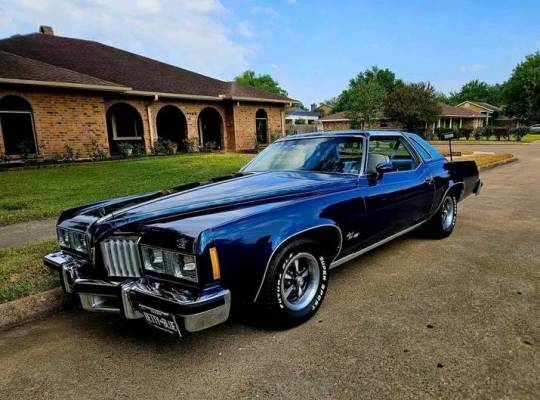
1977 Pontiac Grand Prix
A complete reworking of the front header and bumper highlighted the 1977 Grand Prix, which was the final year for the 1973-vintage bodyshell that was set to be replaced by a downsized GP for 1978. The parking lamps were now positioned between the quad headlamps (same setup as a 1967 or 1968 Oldsmobile Cutlass), and the previous year's 'waterfall' grille was replaced by a narrower one that extended into the lower portion of the bumper. Behind the bumper were new reinforcements (mounting panels) made from aluminum rather than steel to reduce weight. In back the taillights were simplified to eliminate the weighty pot metal bezels that created the horizontal stripe effect in 1976. The same three models (J, LJ, and SJ) were carried over with engine revisions. The base Model J got Pontiac's new 135 hp (101 kW) 301 cu in (4.9 L) V8 as standard equipment, which was much too small and underpowered to propel a 4,000-pound car. Optional engines included a 160 hp (119 kW) 350 cu in (5.7 L) V8 or 180 hp (130 kW) 400 cu in (6.6 L); those two engines standard on the LJ and SJ models, respectively. The original thinking on the 301 CID engine was that the weight savings from using a significantly lighter engine would cancel out the horsepower loss from the smaller displacement. This turned out to be a major miscalculation and 301 equipped cars became much less desirable among Grand Prix enthusiasts and collectors in later years. The 301 also had a knocking (pre-ignition) problem that was later determined to be caused by the shape of the combustion chamber.
Each of those engines were Pontiac-built units as in previous years, but offered in 49 of the 50 states. Because Pontiac's own V8 engines could not meet the more stringent California emission standards set for 1977, all Grand Prixs (and other Pontiac models) sold in California were powered by Oldsmobile-built engines including Lansing's 350 cu in (5.7 L) "Rocket V8" for J and LJ, and the 403 cu in (6.6 L) Rocket V8 standard on the SJ and optional on the other two GPs in California. Due to a shortage of Olds 350 engines resulting from record sales of Cutlasses and reduced production of that engine due to a plant conversion to build a Diesel V8 beginning in 1978, a few 1977 Grand Prixs destined for California reportedly came off the line with a Chevrolet-built 350 cu in (5.7 L) V8.
Grand Prix sales increased to an all-time high of over 270,000 units for 1977, the last year for this bodystyle, despite competition from a newly downsized and lower-priced Ford Thunderbird introduced this year and a restyled Mercury Cougar XR-7 whose bodyshell switched to the T-Bird this year from the discontinued Ford Torino/Mercury Montego.
103 notes
·
View notes
Text
From Sci-Fi to Reality: The Potential for Real-Life Mecha Inspired by Gundam!
I've watched mecha anime, the seriesVoltes V,Robotech, Video Senshi Laserion. In fact the great experience is watching Gundam anime.
In recent years, advances in robotics, artificial intelligence, and engineering have brought the idea of real-life mecha closer to reality. Inspired by iconic series like Gundam, researchers and engineers are exploring the possibilities of creating large, human-piloted robots. While we may not have fully functional Gundams yet, the progress made so far is promising. Let's delve into the current developments and the potential future of real mecha.
It happened during 2018
In Japan, engineer Masaaki Nagumo always dreamed of climbing into his very own Mobile Suit Gundam mecha. As an adult, he finally made that dream a reality.
Photos below:Sakakibara Kikai
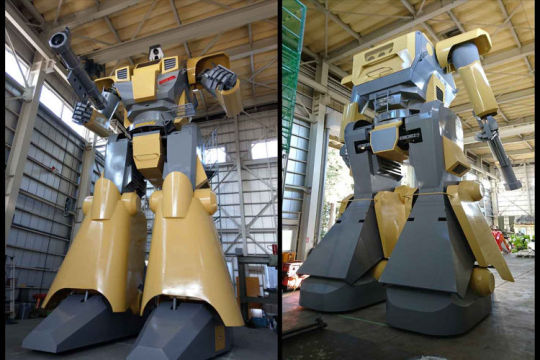
He created the 28-foot-tall, 7-tonne-heavy LW-Mononofu robot as a project for his employer, industrial machinery maker Sakakibara Kikai, in Japan’s Gunma Prefecture. The metal colossus took six years to finish, and is probably the world’s largest anime-inspired robot that you can actually ride in and control. It can move its arms and fingers, turn its upper body, and walk forward and backward at a snail-like speed of 1km/hour. As any respectable mecha, it also has a weapon – a metal gun that fires sponge balls at a speed of 87 mph.T
The LW Mononofu can be powered by both a 200-volt AC electricity source and a 24-volt DC battery. Its cockpit features levers, pedals and buttons that the rider can use to control the movements of the robot, as well as monitors showing live footage shot by cameras installed at five points on its gigantic body.
its only con is that it can't leave the hangar it was built in, because it is higher than the large door. It has to be dismantled to be taken out…
Despit this the enthuthiasts are determined to make the Giant mecha a real.
Well, thanks to the japanese company called Tsubame Industry, that dream is nearly becoming reality. Well, if we can afford paying it, of course. The small Japanese startup recently showcased its newest product, dubbed ‘ARCHAX’, a pilotable robot inspired by Japanese mecha culture. Standing a whopping 4.5 meters tall and weighing around 3.5 tons, this real-life mecha is powered by a 300V battery and can switch from a standing mode to drivable mode, attaining a top speed of 10 kilometers per hour.
Nonetheless,if someone desires to undergo the thrilling journey with the ARCHAX, he has to pay an estimated 400 million yen ($2.75 million) for one.
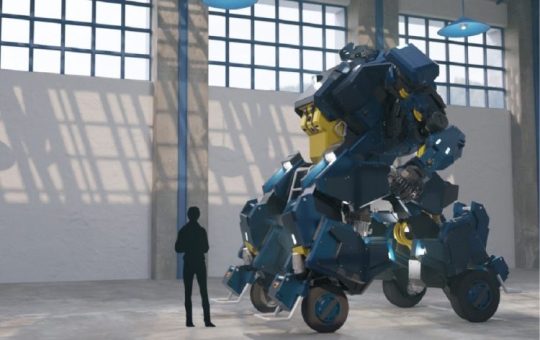

It's name is inspired by that of the flying dinosaur Archeopteryx – was recently showcased in a series of videos posted by Tsubame Industry, and the Japanese startup announced that a working version will be presented at the Japan Mobility Show 2023 (formerly the Tokyo Motor Show) in November. As for when the mecha will hit the market, a Tsubame spokesperson said that it is expected to be available in about a year. However, considering the high price tag, the company is targeting wealthy foreign billionaires as potential clients.
Being made of iron and aluminum alloy, while the outer shell consists mainly of FRP (fiber-reinforced plastic). Although the head appears to feature a large camera, it is only for show. In reality, the pilot maneuvering the ARCHAX will have footage captured by 26 different cameras mounted all over the mecha fed into a number of monitors inside the cockpit. The control panel is reportedly similar to that of construction machinery, consisting of two joysticks, a number of pedals, and a touchscreen. Interestingly, the ARCHAX can also be remote-operated.
This mecha can move at a speed of 2 km/h, and in drive mode that speed is increased to 10 km/h. It’s not exactly soaring through the air like in video games, but it’s better than just standing still. It can tilt forward a maximum of 20 degrees in stand-up mode and 30 degrees in drive mode, to ensure that it doesn’t fall over. If these values are exceeded, the system shuts down to prevent serious accidents. The mecha is subject to risk assessment in accordance with the safety regulations of construction machinery and robots.His mechanical arms have 5 movable fingers, and it can grab a variety of things, still the weight of them is limited to 15 kilograms, for safety reasons. Trying to lift something heavy could cause the mecha to topple, putting the pilot at risk and damaging it.
Conclusion
The journey from science fiction to reality is a challenging but exciting path. While we may not see fully operational Gundams patrolling our cities in the immediate future, the advancements in robotics, AI, and engineering are bringing us closer to realizing the dream of real-life mecha. The fusion of technology and imagination continues to push the boundaries of what is possible, making the future of mecha an exhilarating topic to watch.
#sci fi#science fiction#mecha anime#Mobile Suit Gundam#機動戦士ガンダム#Kidō Senshi Gandamu#Tomino Yoshiyuki#富野 由悠季#Military science fiction#engineer Masaaki Nagumo#robots#real giant robots#ARCHAX mecha#Tsubame Industries#日本国#Japan is great#日本が大好きです#I love Japan#artificial intelligence#giant humanoid robots#technological advancements#日本は素晴らしい#LW-Mononofu#Sakakibara Kikai#サカキバラキカイ
2 notes
·
View notes
Photo
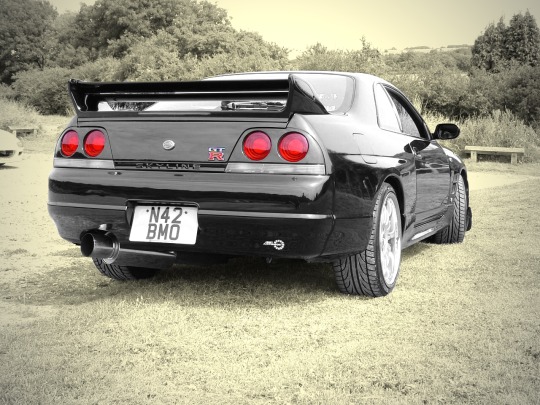
Back in a former life, I had an addiction that I loved beyond sanity. Here’s the story of it. 2002 2003 2004 2005 2006 2007 2008 2009 pt1 2009 pt2 2009 Redux
This is the final spec list for my glorious, insane Brutal Truth.
Nissan Skyline BCNR33 GT-R (Type 2) manufactured in April 1996. JDM non V-Spec vehicle retailed through Osaka Nissan Prince in May/June 1996. Imported to the UK in June 1997. Remained in original JDM spec without speedometer conversion until August 2002. Only the steering wheel & white dial sets were fitted in Japan.
Nismo RB26N1 bare engine: [N1 water pump (improved flow & less cavitation)/Reinforced cylinder block head bolt boss/Increased sump capacity (6L 20w60)/1.2mm oil restrictor]
N1 head with 0.5mm overbore (2598cc)
Cryogenically hardened N1 crankshaft
Wossner forged & cryogenically hardened pistons
Abbey Motorsport reinforced & cryogenically hardened con-rods
ACL Race Series conrod & crankshaft bearings
Tomei sump baffle kit
Tomei high flow (larger drive gears) oil pump
HKS 1.2mm metal head gasket
Tomei Procam Spec 2 cam kit (270 degree inlet & outlet with 10.25mm lift)
HKS V-Cam System Step 1 Type B (variable 248-278 degree inlet; replaces Procam inlet camshaft)
HKS vernier cam pulleys
HKS kevlar reinforced timing belt
Trust metal intake & throttle gaskets
HKS front pipe & decat gaskets
GReddy Iridium 08 Racing sparkplugs
Mocal 19-row oil cooler & Abbey Motorsport remote oil filter assembly
Abbey Motorsport catch tank & washer reservoir with SFS breather hoses
Abbey Motorsport Pro Alloy large radiator
Tomei fuel pump, fuel regulator & 600cc injectors
A’PEXi Power Intake induction kit
A’PEXi GT Spec intercooler (237x610x136mm) & hard pipe kit
HKS GT-SS turbos
HKS twin AFM delete kit
Tomei turbo elbows
HKS downpipes
HKS Silent Hi-Power exhaust
Abbey Motorsport 80mm decat pipe
Mine’s VX-ROM
HKS F-Con V Pro
HKS EVC 6 boost controller (1.6 bar)
AEM wideband lambda sensor
Splitfire DI Super Direct Ignition System
HKS Circle Earth kit
HKS GD Max twin-plate clutch (with lightened flywheel)
Abbey Motorsport rebuilt transfer box
Abbey Motorsport rebuilt gearbox with cryogenically hardened gear set, modified Nissan synchromesh upgrade and OS Giken strengthening plate
Abbey Motorsport rebuilt rear diff
Nismo gearbox mounts
Nismo Solid Shift gear stick (10% short shift)
Omex Shift Light Sequential
Sunsei SE-135 solar panel trickle charger mounted on a custom aluminium riser between the rear parcel shelf speaker enclosures.
Team Dynamics Equinox alloys 19x9.5, ET+15 in silver with polished stainless steel rim.
Falken FK452 265/30/19 Y-rated tyres
Cusco brake master cylinder brace
Cusco rear steering delete kit
Cusco front & rear upper suspension links
AST Sport Line 1 full suspension kit with UK spring setup
Nismo stainless steel braided brake hoses
StopTech 355mm rotor 4 pot caliper front brake kit
StopTech 355mm rotor 2 pot caliper rear brake kit with Abbey Motorsport modified pad retainers
Ferodo DS2500 brake pads front & rear
Bomex AD-390 front splitter
Nismo R34 smoked front indicators in custom aluminium mounting plates finished in crackle black
Nissan Xenon headlamp units
Border Racing Aero Fenders (vented front wings) with silver GT emblems from a R32 Skyline
Nismo smoked side repeaters
Top Mix one-off FRP twin blade rear spoiler on custom aluminium mounting plates
Entire exterior resprayed in BMW black (code 086) base and lacquer
Nissan Motorsport International carbon fibre B-pillar plates
PIAA carbon effect silicon wipers, front pair with spoilers, rear without
Nismo white face dial sets (dashboard & centre console) in carbon fibre panels
AEM AFR gauge mount replaces the lighter socket
HKS EVC display mounted on custom carbon fibre plate replacing the ashtray
Lighter socket relocated to the fog light switch panel
Nissan Momo steering wheel (with airbag)
Dressycar Nismo harness pads
Redline Automotive leather gearstick & handbrake gaiters
Abbey Motorsport carbon fibre door sill trims
Carbon fibre boot sill trim
Inlet plenum and sundry induction pipework finished in powder grey
Trust clear cam pulley cover
HKS Kansai Service carbon fibre spark plug cover
Right hand cam cover finished in crackle black
Nismo radiator & washer reservoir caps
HKS Kansai Service front strut brace finished in high gloss black
GReddy aluminium slam panel finished in crackle black
Tein bonnet dampers with black sleeves
Custom made one-off Cobra Misano Lux front seats: [Alcantara (colour code 9189) outers/Alcantara (colour code 9182) centre panels/One-piece carbon fibre backs/Sidewinder bases on custom subframes adapted by Abbey Motorsport/Cobra logo in silver thread on the headpads/GT-R logo beneath the grommets on seat backs]
JVC KD-AVX2 multi-media DVD/CD receiver with built-in 3.5” widescreen monitor
2x JL Audio Evolution VR600-CXi 6” speakers (front)
2x JL Audio Evolution TR650-CXi 6.5” speakers (rear)
Multiple and interlaced Thatcham rated security systems.
500 bhp. 520 ft/lb.
Ludicrously, hilariously, unbelievably fast.
Hope you enjoyed this little trip down memory lane with me. Cheers! JM.
(Photo by N. Liassides.)
#r33#bcnr33#skyline#gt-r#nissan skyline#Abbey Motorsport#HKS#Bomex#Tomei#A'PEXi#GReddy#Nismo#RB26N1#Mocal#Team Dynamics
12 notes
·
View notes
Text

𝐓𝐇𝐄 𝐋𝐎𝐍𝐄 𝐒𝐔𝐑𝐕𝐈𝐕𝐎𝐑 | @lastsurvivor
A hum echoes out across pearly white walls, with pale yellow roundels providing light, along with a brightly organized glowing console in the center of the room. Complex arrays of buttons and controls befitting the strange ship were organized along six panels. In the console room, a man wearing baggy yellow trousers, a white dress shirt, and a maroon tweed waistcoat with blue patterns along it— quietly adjusted a blue necktie whilst he rolled up his sleeves. Quietly, he hummed, pink flamingo-colored hair tied back in a bunch whilst amber eyes surveyed the console in all its complexities. The TARDIS, she was called, a time-space vessel that soared through the cosmos— the fourth dimension was its personal highway, but she occasionally used the fifth and sixth dimensions as backroads.
"I do like to be beside the—" Humming of the glover-kind tune halted as a beep distracted the Timelord. "—Distress signal?" He circled the console, heading over to the communications array of the TARDIS. "Ah, here we are..." He dials in on the signal, which isn't hard to discern or lock onto— "Looks like we just so happened to be passing by. Space year... 2147..." He began to pull the TARDIS out of the Time Vortex, so the ship could materialize in space near the source of the distress signal. Flicking up a switch on the console that caused a wall-mounted monitor to display the craft the TARDIS was circling, 𝙏𝙝𝙚 𝘿𝙤𝙘𝙩𝙤𝙧's brows furrowed in mild curiosity at what he saw on the screen.
"A commercial escape craft? Looks to be detached from a commercial vessel..." He talked aloud, recognizing specific design patterns associated with other space vessels the traveler had come across before. From a cursory glance of the vessel, The Doctor was able to tell that it was floating in a low power mode, with life signs aboard being relatively faint, and he pondered aloud, "What is it doing all the way out here, though?" Precise scans did pick up life, which prompted him to investigate, "Let's see what we can find, shall we?" Grabbing his multi-colored coat off from the coat rack, The TARDIS engines began to circulate with groaning and wheezing that indicated the ship was landing aboard the escape craft.

Materializing tightly within the frosted escape craft's interior, the POLICE PUBLIC CALL BOX's door sign which read pull to open was yanked as if the door would need to be pushed open. A flashlight beam pointed outward, The Doctor sticking his head out as he observed the state of the interior. Automatically, The TARDIS had extended an air shield within the escape craft's interior. The artificial gravity circuits were still enabled, so all the TARDIS had to do was make the interior breathable. That only left The Doctor to complain about the temperature, however. "I think their heating might be on the mend." He mumbled quietly before his flashlight found the ship's main terminal. Approaching it, The Doctor used clever hands to re-enable the ship's primary computer, causing lights to activate across the terminal. Age had gotten the better of it, so The Doctor's patience was put to the test as he navigated through the ship's flight recorder.
"The Narcissus... Escape craft belonging to The Nostromo..." The Doctor's eyes read a brief report on the ship's status, as well as a list of current crewmembers. Only one name popped up, and The Doctor aimed a flashlight toward a chamber in the room. "Ah. That would be you." He looked back at the computer once more, "That distress call... You were waiting for someone to come pick you up." Without any hesitation, The Doctor entered specific commands into the computer, disengaging the cryo chamber so that whoever was inside would begin to awake. He approached it whilst it hissed quietly, kneeling to the side and aiming the flashlight in an upward direction, so that whoever would emerge would see the man clearly.
"So... who are you...?"
#!!!. {in character | ic}#vii. {the pink doctor}#lastsurvivor#//ALREADY IN LOVE WITH THE IDEA OF THESE TWO TRAVELING TOGETHER#//my favorite show crossing over with my favorite movie?#//sign me up#//I watch 1979 Alien religiously okay#//I was totally kicking my fee tthe entire time I was writing this
3 notes
·
View notes